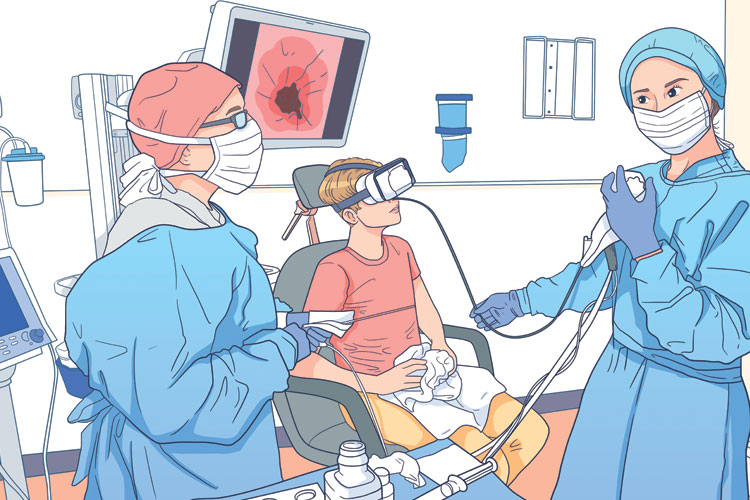This post is also available in:
Español (Spanish)
Français (French)

Image used with permission from the artist, Mosstep.
What is transnasal endoscopy (TNE)?
Transnasal endoscopy (TNE) allows doctors to look at the upper digestive tract without needing deep sedation or general anesthesia. This test is usually done to check for problems in the stomach or throat. Unlike traditional endoscopy, where the child must be sedated or go to the hospital, TNE can be done in the doctor's office while the child is awake. There are several centers in the US that perform TNE.
Why might a child have a TNE?
A TNE can help doctors figure out what is going on in a child’s throat and stomach. It is especially helpful for children who have problems swallowing, feel like there is a lump in their throat, or have acid reflux. TNE also can detect and help monitor a condition called eosinophilic esophagitis.
TNE is an excellent choice for children who need to have more than one endoscopy because they do not have to be sedated multiple times. Compared to a traditional endoscopy, for TNE the child does not need to be hungry for a long time before the test and can go home right after.
TNE requires some cooperation, and young children may be anxious about the test. Your doctor will go over the test with you and your child and decide if TNE is a good option for your child.
What happens before a TNE?
Before the TNE, your healthcare team will give you instructions. You and your child will need to be at the hospital for about 2–3 hours, including check-in and clinic time. A specialist will discuss your child's problems and concerns and will examine your child. The TNE test will be done on the same day. Your child can return to normal activities after leaving the hospital.
How is a TNE done?
TNE is done in a doctor’s office. Before the test, the doctor will spray medicine in your child's nose and throat to numb the area and make sure they do not feel pain. Your child will wear special goggles, and the doctor will put a tiny tube with an attached camera through your child’s nose to look inside their stomach and intestines. The doctor will take some pictures and also may collect a small piece of tissue during the TNE. When the test is over, the doctor will take the tube out, and your child can drink water and go home.
The healthcare facility may have people such as child life specialists who can help your child feel comfortable during the TNE. Some places also may have virtual reality goggles to distract your child during the test.
What are the possible risks of TNE?
TNE can sometimes make a child gag and feel discomfort. These feelings usually go away quickly. There are some rare side effects possible with TNE, such as nosebleeds, infections, and perforation. However, these side effects are not common, and they are possible with sedated endoscopy as well.
What should we watch for after the TNE, and when should we seek medical advice?
After TNE, your child should feel fine. Some children might feel like their throat is numb when they swallow. However, this feeling usually goes away within a few hours after the procedure. If your child has pain that does not go away or has bleeding, contact your doctor immediately.
Authors: Vrinda Bhardwaj, MD, Amornluck Krasaelap, MD, Daniel Duncan, MD, and the Aerodigestive SIG NASPGHAN
Editor: Amanda Deacy, MD
May 2024
This post is also available in:
Español (Spanish)
Français (French)





